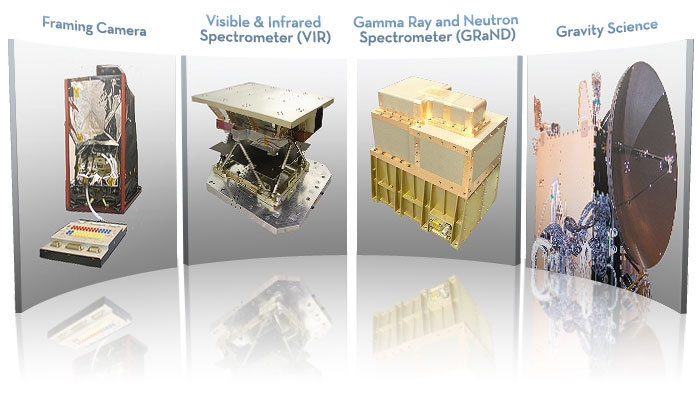Science Payload

Framing Camera (FC)
Captures images of Vesta and Ceres in three colors and black and white.
Developed by the Max Planck Institute for Solar System Research (MPS).
Visible & Infrared Spectrometer (VIR)
Map the full surface of Ceres and Vesta with a spectrometer (measures reflected light intensity in select wavelength bands) to determine their composition, temperature and properties.
Developed by the National Institute of Astrophysics (INAF).
Gamma Ray and Neutron Detector (GRaND)
Produces maps of the elements found on the surface of each asteroid, including the abundance of major rock-forming elements (O, Mg, Al, Si, Ca, Ti, and Fe), trace elements (Gd and Sm), long-lived radioactive elements (K, Th, and U), and light elements such as H, C, and N (important to understand the icy surface of Ceres).
Developed by the Los Alamos National Laboratory (LANL).
Gravity Science
Uses audio tracking signals returned from the surface of Vesta and Ceres to determine their respective mass, gravity field, principal axes, rotational axis and moments of inertia.
Data Return:
- Images of Vesta and Ceres in three colors and black and white
- Full surface with mapping spectrometer in three bands, 0.35 to 0.9 micron, 0.8 to 2.5 micron and 2.4 to 5.0 micron
- Neutron and gamma ray spectra to produce maps of the surface elemental composition of each asteroid, including the abundance of major rock-forming elements (O, Mg, Al, Si, Ca, Ti, and Fe), trace elements (Gd and Sm), long-lived radioactive elements (K, Th, and U), and light elements such as H, C, and N, which are the major constituents of ices.
- Radio tracking to determine mass, gravity field, principal axes, rotational axis and moments of inertia.





